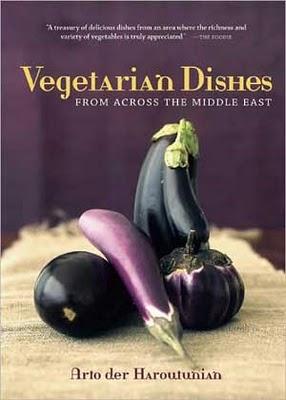Vegetarian Dishes from Across the Middle East

The late Arto der Haroutunian first published this book in 1983 when how-to's for vegetarian cooking—let alone for Middle Eastern vegetarian cooking—were relatively rare in the U.S. Ahead of his time, der Haroutunian's tome of some 250 recipes laid dormant and out of print for 20 years. This new reissue is the first time the book has been available in North America.
As a vegetarian, lover of Middle Eastern food, and cooking newbie, I was thrilled to get my hands on this book. As an added bonus, many of the recipes are vegan, or can be easily tailored to be vegan. I resolved to make half a dozen recipes before reviewing this book, some more than once. After doing so, I've decided that I have a love/hate relationship with said book. My partner, who is an engineer, put it this way: “There is so little instruction that if this was a booklet that came with something you bought at IKEA, it would say, 'Assemble your furniture.'”
Translation: it's assumed that you have as much culinary knowledge as the author. For someone like me—who did not own a set of pots and pans until receiving them as a wedding gift—this made crafting recipes a bit difficult. The recipes don't make any mention of this when referring to the type tools needed—“place mixture in a baking dish”—you're left light on specifics. What kind of baking dish? Pyrex? Stainless? Deep? Shallow?
Some of the baking times were also way off; had I not checked on the potato eggeh, for instance, we might have had a fire in the oven. Ditto with my first try at pita bread: the book forbids you to open the oven before the rounds have baked for 10 minutes, but in my oven that made them a bit tough and crunchy on top. (On my second attempt, baking them for seven minutes, they turned out soft, yummy, and addictive.)
That said, many of the difficulties I encountered could be placed squarely on the shoulders of the American publisher. They failed to take into consideration the fact that flour available for purchase in the U.S. (the cook is simply instructed to use “all-purpose flour”) varies from flour available in the Middle East and the U.K. (the author lived in both places during his lifetime). I seriously doubt the rishta (homemade pasta) was supposed to have the doughy taste that it did; coming up with pasta that tasted like pasta required some research on my part, and the use of semolina flour.
The publisher also did not think to include metric conversion for those of us on this side of the Atlantic; my partner was standing by with a calculator and table, lest I guess wrong and blow up the bread. Lastly, with no photographs—other than the very phallic-looking eggplants on the cover—it was visually disappointing and looked like a textbook.
Despite these disappointments, with a little tinkering, we came up with some delicious homemade food. Other points in the book's favor: all of the ingredients are relatively easy to come by, and don't require a chef's talent to make. Just some patience and experimentation is required.
JM: As noted in the review, it is a U.S. edition.
Is this actually a US edition, or are they just selling the UK version on Amazon? If the latter is the case, it should be no surprise that the measurements are metric and recipes are not taking into account US readers :)
All the more power to you for being a vegetarian. I could never give up eating meat, I love beef and chicken too much.